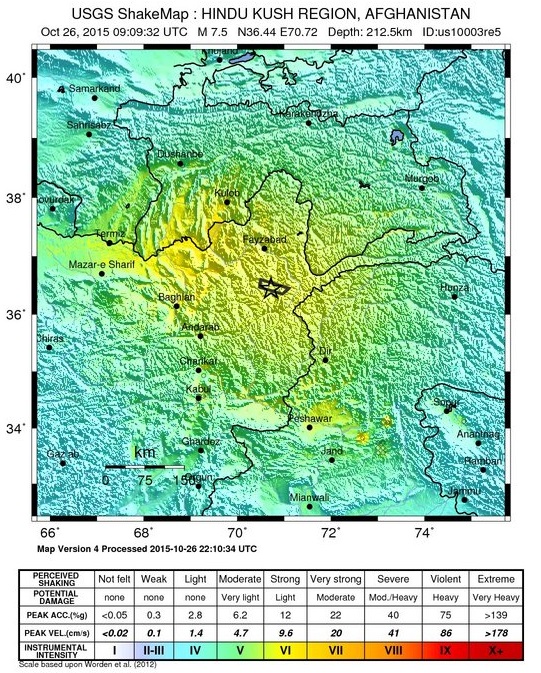Hindu Kush Earthquake
Status: Closed
| Type of posting | Posting date(EST): | Summary | Downloads |
|---|---|---|---|
| First Posting | 10/27/2015 8:00:00 AM |
|
First Posting | Summary
Posting Date: October 27, 2015, 8:00:00 AM
According to the United States Geological Survey (USGS), at 1:39 p.m. local time (09:09 UTC), a magnitude 7.5 earthquake struck northeastern Afghanistan. The epicenter was located in the Hindu Kush mountain range, 45 km (28 miles) north of `Alaqahdari-ye Kiran wa Munjan, Afghanistan, and 254 km (158 miles) north-northeast of Kabul, Afghanistan. The quake struck at a depth of 213 km (130 miles) and was felt in Pakistan, India, Tajikistan, and Kyrgyzstan. The death tolls in Afghanistan and Pakistan currently stand at 50 and 180, respectively, but are expected to rise. The USGS issued an orange alert for shaking-related fatalities, meaning that significant casualties are likely and the disaster is potentially widespread. The USGS also issued a yellow alert for estimated economic losses, meaning that damage-related losses are expected, but will be less than 1% of Afghanistan's GDP.
Regional Seismotectonics
The M7.5 event in Hindu Kush occurred in a seismically active plate boundary zone situated in the northern part of the Indian Plate at a depth of 213 km, according to the USGS (see Figure 1). The 40-50 mm/year north-south convergence between the Indian and Eurasian plates is absorbed in this collisional region, along the Himalayan front, and partly through the numerous thrust faults in the region. This region is a curved arc characterized by intense mountain building and deep seismic events along the northwestern part of the Tibetan Plateau, along the Pamir-Hindu Kush mountains of Tajikistan and northeastern Afghanistan. The immediate epicentral region is situated at the western part of this collision zone, where the crust is unusually thick from the superposition and excessive deformation of rocks from different converging tectonic affinities. Historically the epicentral area is seismically most active along the entire Indian–Eurasian plate collision zone, especially at increased depth. This earthquake occurred at the location where large historic earthquakes of magnitudes 7.0 to 7.5 have repeatedly occurred in the last 100 years, with five earthquakes of magnitudes larger than 7.3 within a radius of about 60 km and in the depth range of 200 to 240 km. The area is a concentration or “hotbed” of seismogenic sources with large earthquakes at unusual depths along the boundary of these two continental plates. The earthquake may be classified as an intermediate depth earthquake, resulting from the interaction of these two major plates. The exact cause of this type of deep earthquake, however, is still not well understood. Other large earthquakes that have occurred along the Indian-Eurasian plate collision zone, such as the 1905 M7.5 Kangra earthquake, the 1934 M8.1 Bihar earthquake, and most recently, the 2005 M7.6 Kashmir earthquake, were all shallow.

Figure 1. ShakeMap of the M7.5 Hindu Kush earthquake in Badakhshan Province, Afghanistan, on October 26, 2015. (Source: USGS)
Expected and Reported Impacts
The earthquake occurred in the mountainous, rural province of Badakhshan in northeastern Afghanistan, and was felt in Pakistan, India, Tajikistan, and Kyrgyzstan. Although the overall economic loss is not expected to be high, the earthquake caused devastating damage to the epicentral regions due to the poor construction of local buildings. The full scope of the damage is not yet clear because the worst affected areas are not easily accessible. The majority of the local building stock is mud brick, or adobe, one of most vulnerable building construction types. Other popular building construction types in the region include unreinforced masonry and some reinforced concrete. Much of the building stock in the affected region is not built to standard because of a lack of code enforcement and code compliance practices. The USGS issued a yellow alert for estimated economic losses, meaning that some damage is possible and economic losses are expected to be less than 1% of the GDP of Afghanistan. The Inspector General of Police in Srinagar, India, stated that a highway overpass had been cracked and that bridges and buildings had also been damaged by the earthquake.
The USGS issued an orange alert level for shaking-related fatalities. Significant casualties are likely, and the disaster is potentially widespread. Past events with this alert level have required a regional or national level response. The death tolls in Afghanistan and Pakistan currently stand at 50 and 180, respectively, but these figures are expected to rise.